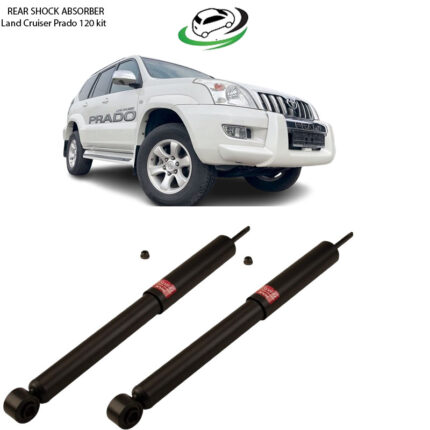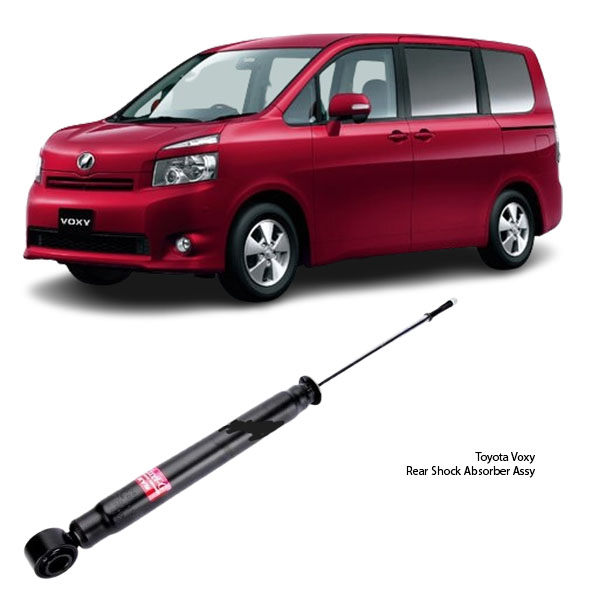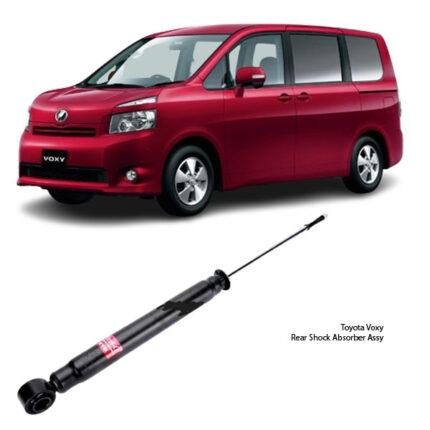Get Toyota Voxy Rear Shock Absorber Assy 344362 in Kenya
A Rear Shock Absorber Assembly is a critical component in your vehicle’s suspension system, located at the back wheels. It’s responsible for controlling the up-and-down movement of your vehicle every time you hit a bump, pothole, or uneven surface. It works by dampening vibrations and keeping your rear tires in constant contact with the road, ensuring you have a smooth, stable, and safe ride.
This component consists of:
Shock Absorber (Damper) – Controls motion by absorbing kinetic energy.
Coil Spring (in some designs) – Helps support the vehicle’s weight.
Mounting Bushings – Reduces noise and vibration where the shock mounts to the chassis.
Dust Cover/Boot – Protects the shock’s internal piston from dirt and debris.
The Role of Rear Shock Absorbers
Unlike the front wheels, which often have steering functions, rear wheels are usually responsible for vehicle stability and traction. The rear shock absorbers ensure:
Your vehicle stays stable, even on bumpy roads.
Tires stay firmly planted for better braking and cornering.
You enjoy a comfortable ride instead of bouncing around like a basketball.
Reduces wear on tires and suspension components.
How Rear Shock Absorbers Work
Inside the shock absorber is a piston moving through hydraulic fluid. When your wheel hits a bump, the piston compresses the fluid, converting kinetic energy into heat. This dampening action prevents excessive bouncing.
Compression Stroke – When the wheel moves up, the shock compresses.
Rebound Stroke – When the wheel moves down, the shock extends.
This constant compression and rebound cycle smooths out vibrations and prevents your rear end from becoming unstable.
Why Rear Shock Absorbers are Critical for Safety
A failing rear shock absorber isn’t just uncomfortable — it’s dangerous. If the rear wheels lose contact with the road, your car loses its ability to brake effectively and handle corners safely. This could lead to:
Longer braking distances
Loss of control in emergency maneuvers
Uneven tire wear
Increased wear on suspension and chassis components
Types of Rear Shock Absorbers
There are different designs depending on vehicle type and suspension setup:
1. Twin-Tube Shocks
Most common design
Affordable and reliable
Suitable for daily driving
2. Monotube Shocks
High-performance design
Better heat dissipation
Ideal for sportier driving or rough terrain
3. Coilover Shock Assemblies
Combines shock and spring in one unit
Common in performance cars and off-road setups
Adjustable ride height and damping
Signs Your Rear Shock Absorbers Need Replacing
Over time, shocks wear out — and when they do, your car will tell you. Common signs include:
Excessive Bouncing – Your car keeps bouncing after hitting a bump.
Poor Handling – Feels loose, especially around corners.
Nose Diving – Rear shocks affect front-end behavior too. If the rear dips under acceleration, or the front dives under braking, shocks may be worn.
Uneven Tire Wear – Rear tires develop cupping (scalloped pattern).
Fluid Leaks – Visible oil leakage on the shock body.
Strange Noises – Knocking or clunking sounds from the rear suspension.
Rear Sagging – Car sits lower at the back, especially when loaded.
Benefits of New Rear Shock Absorbers
Replacing worn rear shocks transforms your vehicle. Here’s what you’ll gain:
Better Ride Comfort – Smoother trips over bumps.
Enhanced Safety – Improved braking and stability.
Reduced Tire Wear – Even contact patch reduces uneven tread wear.
Less Stress on Other Components – Protects springs, bushings, and chassis from excessive movement.
More Control – Especially important if towing or carrying heavy loads.
When to Replace Rear Shock Absorbers?
Most shocks are designed to last between 80,000 to 100,000 km, but this varies based on:
Driving Conditions – Rough roads shorten lifespan.
Driving Style – Aggressive driving wears them faster.
Load – Carrying heavy loads stresses shocks more.
Quick Test: The Bounce Test!
Push down hard on your vehicle’s rear corner and release. If the vehicle bounces more than once or twice, your shocks may be worn.
Rear Shock Absorber Maintenance Tips
Keep your shocks healthy with these habits:
Inspect shocks every service interval for leaks and damage.
Replace in pairs — both left and right — for balanced handling.
Use high-quality parts from trusted brands.
Avoid overloading the rear of your vehicle.
Address suspension noises early before shocks and other parts suffer collateral damage.
Rear Shock Absorber vs Rear Strut – What’s the Difference?
Some people confuse shocks with struts. Here’s the difference:
Shock Absorber – Only controls motion. Separate spring supports weight.
Strut Assembly – Combines shock and spring into one structural unit.
Most modern cars have struts in the front and shocks in the rear, but this varies.
Can You Replace Rear Shocks at Home?
If you’re mechanically inclined, replacing rear shocks can be a DIY job, provided you have:
Jack and jack stands
Socket set
Torque wrench
Steps (Basic Overview):
Lift the vehicle and remove rear wheels.
Locate and remove old shocks.
Install new shocks and torque bolts to spec.
Reinstall wheels and lower vehicle.
Test drive to confirm improved ride quality.




